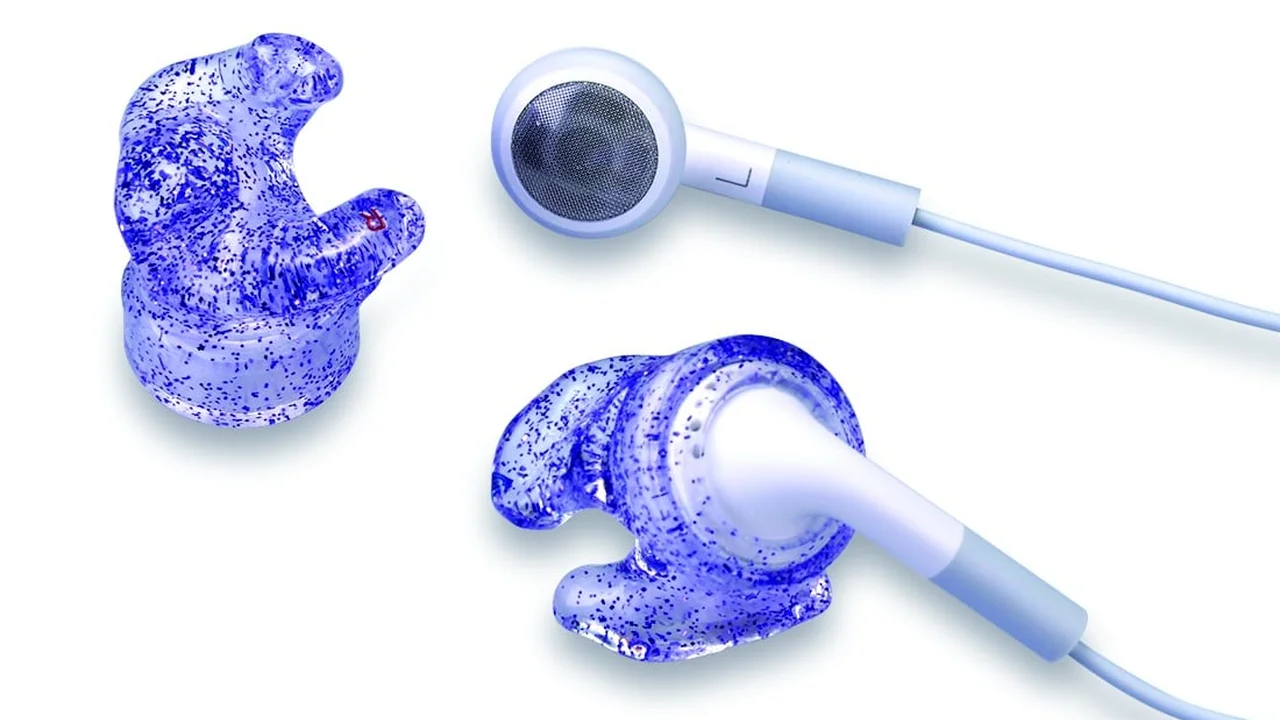Custom Earmolds For Hearing Aids Benefits
Understand the advantages of custom earmolds for hearing aids, including improved comfort, better sound quality, and reduced feedback.

Custom Earmolds For Hearing Aids Benefits
When it comes to hearing aids, one size definitely does not fit all. While many hearing aids come with standard domes or tips, custom earmolds are precisely what they sound like: molds made specifically for the unique shape of your ear canal. This personalized approach offers a host of advantages that can significantly enhance your hearing aid experience. Think of it like getting a custom-tailored suit versus an off-the-rack one – the fit, comfort, and performance are just on another level.
Why Custom Earmolds Matter for Hearing Aid Users
Let's break down the core reasons why custom earmolds are often recommended and why they can be a game-changer for many individuals with hearing loss.
Enhanced Comfort and Secure Fit with Custom Earmolds
One of the most immediate and noticeable benefits of custom earmolds is the unparalleled comfort they provide. Standard domes, while convenient, can sometimes feel loose, cause irritation, or even fall out. Custom earmolds, on the other hand, are designed to fit your ear canal perfectly, like a glove. This means:
- No more slipping: The secure fit ensures your hearing aid stays in place, even during physical activity or when you're on the go. This is particularly beneficial for active individuals, children, or anyone who finds their hearing aids constantly shifting.
- Reduced pressure points: Because the mold is custom-made, it distributes pressure evenly across the ear canal, minimizing discomfort and soreness that can sometimes arise from ill-fitting standard tips.
- Longer wear time: With increased comfort, you're more likely to wear your hearing aids for longer periods throughout the day, maximizing their benefit.
Superior Sound Quality and Clarity from Custom Earmolds
Beyond comfort, custom earmolds play a crucial role in optimizing the sound quality delivered by your hearing aids. Here's how:
- Minimized sound leakage: A perfect seal prevents sound from escaping the ear canal, ensuring that all the amplified sound reaches your eardrum. This is vital for maximizing the effectiveness of your hearing aid's amplification.
- Improved bass response: When sound leaks, you often lose the lower frequencies (bass). Custom earmolds create a better seal, allowing for a richer, fuller sound experience, which can make music and certain speech sounds much clearer.
- Consistent sound delivery: Because the earmold is securely in place, the sound path to your eardrum remains consistent, leading to more stable and predictable sound quality throughout the day.
Eliminating Annoying Feedback with Custom Earmolds
Ah, feedback – that high-pitched whistling sound that can be incredibly frustrating for hearing aid users and those around them. Custom earmolds are highly effective at combating this common issue:
- Acoustic seal: Feedback occurs when amplified sound leaks out of the ear canal and is picked up by the hearing aid's microphone, creating a loop. A custom earmold creates a tight acoustic seal, preventing this leakage and significantly reducing or eliminating feedback.
- Higher amplification potential: With feedback under control, your audiologist can often increase the amplification levels of your hearing aid without causing whistling, which is especially beneficial for individuals with more severe hearing loss.
Durability and Longevity of Custom Earmolds
While standard domes are often disposable and need frequent replacement, custom earmolds are built to last. Made from durable materials like acrylic or silicone, they can withstand daily wear and tear for years with proper care. This not only saves you money on replacements but also ensures a consistent fit and performance over time.
Better Performance in Noisy Environments with Custom Earmolds
For many hearing aid users, noisy environments are the biggest challenge. Custom earmolds can offer a significant advantage here:
- Improved signal-to-noise ratio: By creating a better seal, custom earmolds help to isolate the desired sound (speech) from unwanted background noise. This improves the signal-to-noise ratio, making it easier for your hearing aid's noise reduction features to work effectively and for you to focus on conversations.
- Reduced external noise intrusion: The physical barrier of the custom earmold can also help to passively block some external noise, further enhancing your ability to hear in challenging listening situations.
Types of Custom Earmold Materials and Styles for Hearing Aids
Custom earmolds aren't just one type; they come in various materials and styles, each with its own characteristics. Your audiologist will help you choose the best option based on your hearing loss, lifestyle, and personal preferences.
Acrylic Earmolds for Hearing Aids
Acrylic is a hard, durable material that is very common for earmolds. It's easy to clean and can be polished to a smooth, comfortable finish. Acrylic earmolds are often chosen for:
- Durability: They are very resistant to wear and tear.
- Ease of insertion: Their smooth surface makes them easy to insert and remove.
- Good for mild to moderate hearing loss: They provide a good seal for many types of hearing loss.
Silicone Earmolds for Hearing Aids
Silicone is a softer, more flexible material that offers a very comfortable fit. It's often preferred for:
- Comfort: The soft material conforms to the ear canal, making it ideal for sensitive ears or those who experience discomfort with harder materials.
- Secure fit for active users: Its flexibility helps it stay in place during movement, making it great for athletes or children.
- Excellent seal for severe hearing loss: Silicone provides a superior acoustic seal, which is crucial for preventing feedback in individuals with significant hearing loss.
- Impact resistance: Less likely to crack or break if dropped.
Vinyl Earmolds for Hearing Aids
Vinyl earmolds are softer than acrylic but firmer than silicone. They offer a good balance of comfort and durability. However, they can sometimes harden over time and may be more prone to discoloration.
Different Earmold Styles for Various Hearing Aid Types
The style of your earmold will depend on the type of hearing aid you have:
- Full Shell: Fills the entire concha bowl of the ear. Provides the best seal and is often used with Behind-The-Ear (BTE) hearing aids for severe to profound hearing loss.
- Half Shell: Fills about half of the concha bowl. Offers a good balance of retention and cosmetic appeal, often used with BTEs for moderate to severe hearing loss.
- Canal: Sits primarily in the ear canal, with a small portion visible in the concha. More discreet, used with BTEs for mild to moderate hearing loss.
- Skeleton: Similar to a full shell but with the center removed, leaving a 'skeleton' outline. Offers good retention with less bulk.
- Receiver-In-Canal (RIC) or Receiver-In-Ear (RIE) Molds: These are smaller, custom tips designed specifically for RIC/RIE hearing aids, where the receiver (speaker) sits inside the ear canal. They provide a better seal and more secure fit than standard domes for these popular devices.
The Process of Getting Custom Earmolds for Your Hearing Aids
Getting custom earmolds is a straightforward process, typically handled by an audiologist or hearing aid dispenser. Here's what you can expect:
Step 1: Ear Impression Taking for Custom Earmolds
This is the most crucial step. Your audiologist will carefully examine your ear canal to ensure it's clear of wax or any obstructions. Then, they will insert a small foam block into your ear canal to protect your eardrum. A soft, putty-like material (similar to dental impression material) is then injected into your ear. This material will fill the contours of your ear canal and outer ear. It takes a few minutes to set, during which you'll need to remain still. The process is painless and safe.
Step 2: Earmold Fabrication and Customization
Once the impression has hardened, it's carefully removed from your ear. This impression is then sent to a specialized lab where skilled technicians use it to create your custom earmolds. They will trim, grind, and polish the material to match the exact specifications and style chosen. This process can take anywhere from a few days to a couple of weeks.
Step 3: Fitting and Adjustments for Your New Custom Earmolds
Once your custom earmolds are ready, you'll return to your audiologist for a fitting. They will ensure the earmolds fit comfortably and securely with your hearing aids. Minor adjustments can often be made on the spot to optimize the fit and comfort. This is also an opportunity to discuss any initial impressions or concerns you might have.
Specific Product Recommendations and Use Cases for Custom Earmolds
While custom earmolds are generally made by specialized labs based on your audiologist's prescription, certain hearing aid brands are known for their excellent custom earmold options or integrate custom-fit solutions directly into their product lines. It's important to remember that the earmold itself is a component that works with your hearing aid, not a standalone product in the same way a hearing aid is.
Custom Earmolds for Behind-The-Ear (BTE) Hearing Aids
BTE hearing aids are often paired with custom earmolds, especially for moderate to profound hearing loss. The earmold connects to the BTE device via a tube. Brands like Phonak, Oticon, Widex, and ReSound all offer excellent custom earmold options through their audiologist networks. For example:
- Phonak Power Earmolds: Often recommended for their powerful BTE models like the Phonak Naída Paradise, these custom molds ensure maximum amplification without feedback, crucial for severe hearing loss. They come in various materials, with silicone being popular for comfort and seal.
- Oticon Xceed Custom Earmolds: Designed to work seamlessly with Oticon's super-power BTEs, these earmolds are engineered to deliver clear sound and prevent feedback, even at high amplification levels.
Use Case: An individual with severe hearing loss who needs powerful amplification and struggles with feedback from standard domes. A full-shell silicone earmold would provide the best seal and comfort for all-day wear.
Estimated Cost: The cost of custom earmolds typically ranges from $50 to $200 per ear, depending on the material, style, and the clinic's pricing. This is usually a separate cost from the hearing aid itself, though some premium hearing aid packages might include them.
Custom Earmolds for Receiver-In-Canal (RIC) Hearing Aids
RIC hearing aids are incredibly popular, and while they often use standard domes, custom RIC earmolds (sometimes called custom tips or micro-molds) can significantly improve their performance, especially for those with more significant hearing loss or feedback issues.
- Signia Custom Click Sleeves: Signia offers custom-made Click Sleeves that snap onto their RIC receivers. These provide a superior fit and acoustic seal compared to universal domes, enhancing sound quality and reducing feedback. They are often made from soft silicone.
- Starkey Custom RIC Tips: Starkey also provides custom-fit tips for their RIC devices, ensuring optimal sound delivery and comfort. These are particularly useful for users who find standard domes uncomfortable or prone to slipping.
Use Case: A person with moderate hearing loss using RIC hearing aids who experiences occasional feedback or wants a more secure and comfortable fit for an active lifestyle. A custom silicone RIC tip would be ideal.
Estimated Cost: Custom RIC tips are generally on the lower end of the earmold price range, often between $50 and $150 per ear, due to their smaller size and simpler design compared to full BTE earmolds.
Custom In-The-Ear (ITE) and In-The-Canal (ITC) Hearing Aids
It's worth noting that ITE and ITC hearing aids are inherently custom-made. The entire shell of these devices is a custom earmold, housing all the electronic components. So, when you purchase an ITE or ITC hearing aid, you are already getting a custom-fit solution.
- Widex Moment Custom: This is an example of a fully custom-made ITE hearing aid that is precisely molded to your ear, offering exceptional sound quality and discretion.
- Resound ONE Custom: ReSound's custom-made ITEs are designed to sit comfortably and securely in your ear, utilizing your unique ear anatomy for natural sound localization.
Use Case: Individuals seeking maximum discretion and a completely custom fit, where the hearing aid itself is the custom earmold. Suitable for mild to severe hearing loss, depending on the power and size of the ITE/ITC device.
Estimated Cost: The cost of these devices includes the custom molding process and the electronics, so it's part of the overall hearing aid price, which can range from $1,500 to $4,000+ per ear, depending on technology level.
Maintaining Your Custom Earmolds for Hearing Aids
Just like your hearing aids, custom earmolds require regular cleaning and care to ensure optimal performance and longevity. Here are some tips:
- Daily wiping: Use a soft, dry cloth to wipe down your earmolds daily to remove earwax and debris.
- Weekly cleaning: For a more thorough clean, detach the earmold from the hearing aid (if it's a BTE or RIC mold) and wash it with mild soap and warm water. Make sure to rinse it thoroughly and dry it completely before reattaching it to your hearing aid. Use an air blower to clear any moisture from the tubing.
- Avoid harsh chemicals: Do not use alcohol or other harsh cleaning agents, as these can damage the earmold material.
- Store properly: When not in use, store your hearing aids and earmolds in their case, away from extreme temperatures and moisture.
- Regular checks: Periodically inspect your earmolds for any cracks, discoloration, or changes in fit. If you notice any issues, contact your audiologist.
When to Consider Custom Earmolds for Your Hearing Aids
While custom earmolds offer many benefits, they might not be necessary for everyone. Here are some scenarios where they are particularly recommended:
- Moderate to severe hearing loss: The superior seal helps prevent feedback and ensures maximum amplification.
- Feedback issues: If you constantly experience whistling from your hearing aids, custom earmolds are often the best solution.
- Discomfort or poor retention with standard domes: If your current tips are uncomfortable, cause irritation, or frequently fall out, a custom fit will make a huge difference.
- Active lifestyle: For athletes, children, or anyone who moves a lot, the secure fit of custom earmolds is invaluable.
- Specific ear canal anatomy: Some ear canals have unusual shapes that make it difficult to achieve a good fit with standard domes.
- Desire for optimal sound quality: If you're looking for the absolute best sound experience from your hearing aids, custom earmolds can help achieve it.
Addressing Common Concerns About Custom Earmolds for Hearing Aids
It's natural to have questions or concerns before committing to custom earmolds. Let's tackle a few common ones:
Are Custom Earmolds Uncomfortable?
Initially, any new object in your ear might feel a bit strange. However, custom earmolds are designed for maximum comfort. If you experience persistent discomfort, it's crucial to tell your audiologist. They can often make minor adjustments to improve the fit. The soft silicone options are particularly known for their comfort.
Do Custom Earmolds Block Out Too Much Sound?
The primary purpose of custom earmolds is to create an acoustic seal for your hearing aid's amplified sound. While they do offer some passive noise reduction, they are not designed to completely block out all external sound. Your audiologist can also incorporate 'vents' into the earmold design. These tiny channels allow some natural sound to enter the ear and can help reduce the 'occlusion effect' (the feeling of your own voice sounding hollow or boomy). The size and type of vent will be chosen based on your hearing loss and preferences.
How Often Do Custom Earmolds Need to Be Replaced?
Custom earmolds are quite durable. Acrylic molds can last for many years, while silicone molds might need replacement every 2-4 years, especially if they start to harden or if your ear canal shape changes (which can happen over time, particularly in children). Regular checks by your audiologist will help determine if a replacement is needed.
Can I Get Custom Earmolds for My Existing Hearing Aids?
Yes, in most cases, you can get custom earmolds for your existing BTE or RIC hearing aids. Your audiologist will assess your current devices and recommend the appropriate earmold style and material to work with them.
The Investment in Custom Earmolds for Better Hearing Aid Performance
While there's an additional cost associated with custom earmolds, many users find the investment well worth it. The benefits of improved comfort, superior sound quality, and reduced feedback can dramatically enhance your overall hearing aid experience and lead to greater satisfaction with your devices. It's about optimizing the performance of your hearing aids to truly meet your hearing needs and improve your quality of life.
So, if you're struggling with any of the issues mentioned above, or simply want to get the absolute best out of your hearing aids, talk to your audiologist about custom earmolds. They can assess your specific situation, take precise impressions, and guide you through the process to ensure you achieve the perfect fit and optimal hearing performance.
:max_bytes(150000):strip_icc()/277019-baked-pork-chops-with-cream-of-mushroom-soup-DDMFS-beauty-4x3-BG-7505-5762b731cf30447d9cbbbbbf387beafa.jpg)






